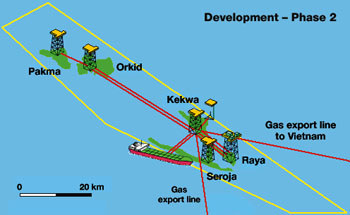International
Beyond OPEC, industry activity moves onWell, hallelujah, OPEC members have finally held their latest quota meeting – maybe now the global upstream industry can get on with business at hand. As many readers probably know, the organization that blanches at being called a "cartel" agreed during the last week of March to raise its collective crude output 7%, or about 1.7 million bpd. This includes last-minute participation by Iran, whose 265,000-bopd contribution went through an off-again, on-again cycle of intrigue. Tehran eventually said it would raise output, but only "to keep other producers from taking away our market share," not because Iran agrees with OPEC’s plan. Sure folks – whatever reason makes you happy. In addition, another 400,000 bopd is expected to be added to global output by such non-OPEC producers as Mexico (150,000 bopd) and Norway (100,000 bopd). Perpetually eager to keep his name in the headlines, U.S. Energy Secretary Bill Richardson (rumored to be a potential running mate with the probable Democratic presidential nominee, Vice President Al Gore) is predicting that OPEC members will "bust" their collective quota by about 400,000 bopd. Just how these various factors will affect oil price levels remains to be seen. The U.S. Energy Information Administration predicted after OPEC’s meeting that prices will drop from $26/bbl in early April to $25/bbl next month and on down to $23.50/bbl by the end of December. For their part, OPEC members reportedly are shooting for a range of $22 to $28/bbl. These sets of numbers are close enough to suggest that maybe the global E&P industry finally will have some price stability upon which to do some capital spending. After all, weren’t unstable prices used as the excuse for why so many oil companies, particularly the largest, failed to boost E&P activity to previously forecast levels for first-quarter 2000? Speaking of capital spending, what follows is some further news about new projects and other notable events. Malaysia/Viet Nam project underway. Readers will notice that this month’s issue includes our feature article on Malaysian E&P. While that article is rather comprehensive, it does not include mention of one project that was omitted, due to uncertain timing on a final decision. After the article went to press, Lundin Oil did announce that its $620-million Phase 2 development of offshore Block PM3-CAA in the Malaysia-Vietnam Commercial Arrangement Area has begun.
In partnership with Petronas-Carigali and Petrovietnam, Lundin’s Phase 2 development of five oil and gas fields includes a central production platform (CPP) on Bunga Kekwa field, plus satellite platforms on Bunga Raya, Bunga Orkid and Bunga Pakma fields. Wellstreams from those fields will be transported by pipeline to the CPP via a separate wellhead riser platform (WHRP). Processed oil and condensate will be commingled and evacuated via the WHRP to an FSO vessel anchored about 1 mi away. Processed gas also will be moved from the WHRP to a gas export pipeline. A Lundin management team has engaged a contractor to provide detailed drawings and specifications by the end of August. In addition, detailed specs are being developed for a 130,000-dwt FSO, for which tendering of the hull should occur by midyear. If all project sectors stay on schedule, first gas production should be achieved by third-quarter 2003. Cuba initiates deepwater offering. Cuban officials in March formally invited foreign oil companies to bid on joint ventures to explore long-term deepwater blocks in Cuba’s portion of the Gulf of Mexico (GOM). Vice Minister of Basic Industry Tomas Benitez told Reuters that six firms from Europe, Canada and Latin America had shown interest, although he declined to name them. Cuba’s GOM territory is divided into 59 blocks that average 2,000 sq km, each. The average water depth is 2,000 m, but some tracts have waters as deep as 4,000 m. Cuban oil production, confined to onshore fields, is running at 50,000 bpd, or quadruple the rate of the early 1990s, when the sector was opened to foreign investment. Local oil and gas production now accounts for one-third of the country’s needs, including 55% of electricity generation. Congratulations to Statoil. A Norwegian and Northwest European record was set recently, when Statoil’s Statfjord-A platform produced continuously for 180 days without power failures or other processing disruptions that would require a shutdown. This performance during the period ending March 30, 2000, was achieved by one of the oldest installations operating offshore Norway – Statfjord-A began producing more than 20 years ago. Meanwhile, Statoil has revised the cost estimate for the Åsgard oil and gas field project to NKr 65.68 billion (US$7.77 billion). The new figure covers four development portions, of which one will cost more, and the other three will now be less expensive. Bongkot field hits milestone.
Thailand’s state upstream firm, PTTEP, celebrated on March 30, 2000, the
10th anniversary of Total’s (now Total Fina’s) decision to commercially develop
Bongkot offshore gas field. Since going onstream in 1993, the field has produced more than
800 Bcfg and 20 million bbl of condensate. PTTEP took over operatorship from Total in July
1998. Current output runs at 550 MMcfgd and 14,000 bcpd. |




